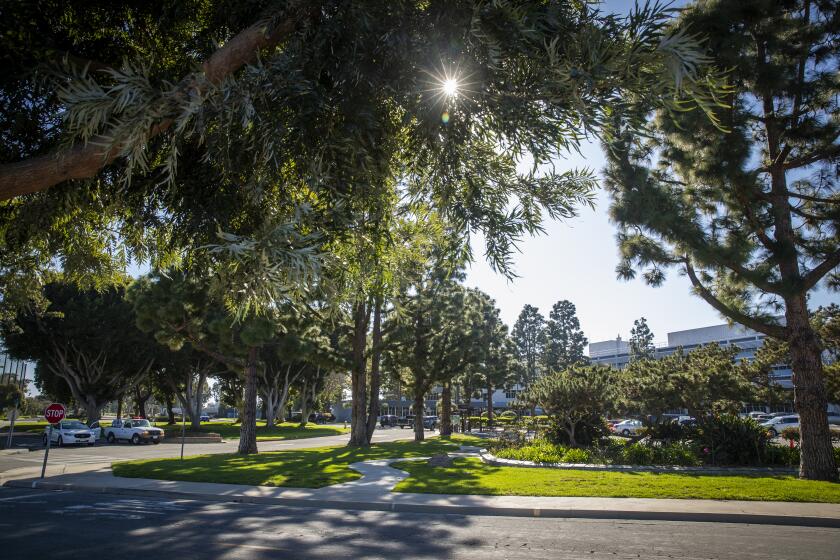Costa Mesa drafting affordable housing law for new projects

- Share via
When the Costa Mesa City Council met in 2016 to consider requiring developers to include a percentage of affordable units in new housing projects as a means of securing shelter for lower income residents, the discussion met a dead end.
Then-Mayor Pro Tem Jim Righeimer said an inclusionary housing ordinance constituted “socialized housing” and amounted to theft by depriving developers of their right to sell homes at fair market value.
“If you cannot afford to live here and your kids can’t have decent housing, you should look at where you can afford,” Righeimer said before the council agreed not to advance such a policy.
Later that year citizens approved Measure Y, mandating certain large-scale developments be put before the voting public for approval, a move some say stymied growth and kept much-needed homes from being built.
To fulfill a mandate that Costa Mesa accommodate 11,760 new residential units by 2029, leaders are surveying every possibility before an Oct. 15 deadline.
Seven years later, as California faces a critical housing shortage, city leaders are looking for new ways to spur residential development and comply with a state order to plan and zone for 11,760 new housing units by 2029.
A city-sponsored Measure K, which passed in November by just 22 votes, repealed the Measure Y mandates in certain industrial and commercial corridors, paving the way for rezoning that will eventually allow for the building of high-density housing.
And now, with 47% of residents living in low-income households and nearly half of all renters spending more than one-third of their incomes on rent, city leaders are once more considering an inclusionary housing ordinance. But this time, it just might work.
The City Council and Planning Commission on Tuesday held a joint study session to explore how such a policy might create more affordable housing without being so stringent as to discourage developers from building in Costa Mesa.
The City Council will discuss Tuesday whether the now-defunct state hospital grounds could accommodate up to 2,300 residential units. The discussion is the first step in a planning process toward which the state has committed $3.5 million.
Kathe Head, president of Los Angeles-based firm Keyser Marston Associates, shared different options and opportunities for drafting an ordinance that would create standards builders had to meet. Developers, in turn, could get entitlements to build bigger projects more easily.
Eight cities in Orange County have inclusionary housing programs, including Huntington Beach, where projects of three or more units must set aside 10% of the total units for renters who earn 80% or less of the area median income. Developers may alternatively pay an in-lieu fee, develop the required units off site or rehabilitate a commensurate number of existing apartment units in town.
Head advised Costa Mesa policymakers to define their own unit thresholds, set-aside levels and alternatives that worked for them.
“You don’t want to be confiscatory, you don’t want to deprive a property owner of a fair and reasonable return on their investment and you don’t want to create a constraint to housing,” she said. “You have to have developers building housing in order to get housing.”
Commissioners and council members discussed the possibility of establishing different low-income housing requirements for different areas in town.
For example, parcels to be rezoned under Measure K or at the state-owned Fairview Developmental Center, where the city hopes to redevelop roughly 100 acres into high-density housing, could incorporate a higher percentage of low-income units.
Some panelists expressed a desire to accommodate the 29% of Costa Mesa households identified as very low- or extremely low-income.
“That’s where I’d like to focus, in particular,” said Councilwoman Andrea Marr. “They are at the most risk of living in unsafe housing conditions, of massive overcrowding and of not being participating members of society.”
Councilman Manuel Chavez expressed an interest in encouraging projects that qualified for high density housing bonuses from the state. He cited a recent Los Angeles Times article that indicated more than 7,700 residents moved out of Costa Mesa ZIP codes 92626 and 92627 between 2019 and 2022, likely due to high housing costs.
“We are shrinking as a city — there are people who lived here who could no longer live here anymore,” he said.
Mayor John Stephens agreed something needed to be done to incentivize home building.
“We haven’t had any housing developments in the city to speak of since 2016,” he said. “We have a pent-up situation, where we actually need to catch up.”
Head and city staff agreed to consider comments and questions generated during the discussion as they developed recommendations for an ordinance to be brought to the planning commission and council in the future.
All the latest on Orange County from Orange County.
Get our free TimesOC newsletter.
You may occasionally receive promotional content from the Daily Pilot.






